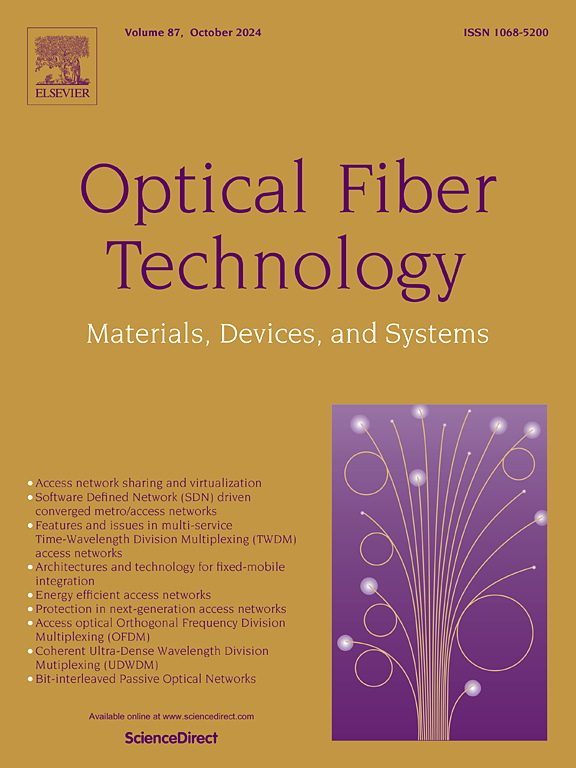A strain sensor based on vernier effect for long air-microcavity Fabry Perot interferometer
IF 2.6
3区 计算机科学
Q2 ENGINEERING, ELECTRICAL & ELECTRONIC
引用次数: 0
Abstract
A strain sensor based on long air-cavity Fabry Perot interferometer (LAFPI) is proposed. A single-mode fiber (SMF) undergoes wet chemical etching followed by delayed tapered welding to create a long air-microcavity with a cavity length of 184.25 μm and a free spectral range (FSR) of 6.52 nm. The delayed welding technique extends the cavity length of the LAFPI, thereby reducing the FSR, which facilitates the vernier effect. By cascading the simulated reference arm, the sensitivity amplification factor of LAFPI becomes easily adjustable, while the reference arm remains unaffected by environmental conditions, making the sensor suitable for various detection requirements. The strain sensitivity of the LAFPI was measured at 3.23 pm/με, and the sensitivity is enhanced to 36.32 pm/με, achieving an amplification of 11.18 times by vernier effect. Furthermore, the air-microcavity demonstrated temperature insensitivity, with a maximum wavelength shift of only 0.05 nm in the resonance valley over a temperature range of 30–100℃, highlighting its resistance to temperature interference. This sensor offers notable advantages, including adjustable high sensitivity, temperature resistance, simple production process, and low cost. It is well-suited for strain measurement in complex environments, demonstrating significant commercial potential.
基于游标效应的长空气微腔法布里佩罗干涉仪应变传感器
提出了一种基于长空腔法布里-珀罗干涉仪的应变传感器。将单模光纤(SMF)进行湿法化学刻蚀,然后进行延迟锥形焊接,形成长空腔,空腔长度为184.25 μm,自由光谱范围(FSR)为6.52 nm。延迟焊接技术延长了LAFPI的空腔长度,从而降低了FSR,有利于游标效应。通过级联模拟参考臂,LAFPI的灵敏度放大系数变得易于调节,同时参考臂不受环境条件的影响,使传感器适用于各种检测要求。LAFPI的应变灵敏度为3.23 pm/με,通过游标效应将灵敏度提高到36.32 pm/με,放大了11.18倍。此外,空气-微腔在温度30-100℃范围内谐振谷的最大波长位移仅为0.05 nm,表现出对温度干扰的抵抗能力。该传感器具有可调高灵敏度、耐高温、生产工艺简单、成本低等显著优点。它非常适合复杂环境中的应变测量,显示出巨大的商业潜力。
本文章由计算机程序翻译,如有差异,请以英文原文为准。
求助全文
约1分钟内获得全文
求助全文
来源期刊

Optical Fiber Technology
工程技术-电信学
CiteScore
4.80
自引率
11.10%
发文量
327
审稿时长
63 days
期刊介绍:
Innovations in optical fiber technology are revolutionizing world communications. Newly developed fiber amplifiers allow for direct transmission of high-speed signals over transcontinental distances without the need for electronic regeneration. Optical fibers find new applications in data processing. The impact of fiber materials, devices, and systems on communications in the coming decades will create an abundance of primary literature and the need for up-to-date reviews.
Optical Fiber Technology: Materials, Devices, and Systems is a new cutting-edge journal designed to fill a need in this rapidly evolving field for speedy publication of regular length papers. Both theoretical and experimental papers on fiber materials, devices, and system performance evaluation and measurements are eligible, with emphasis on practical applications.
 求助内容:
求助内容: 应助结果提醒方式:
应助结果提醒方式:


